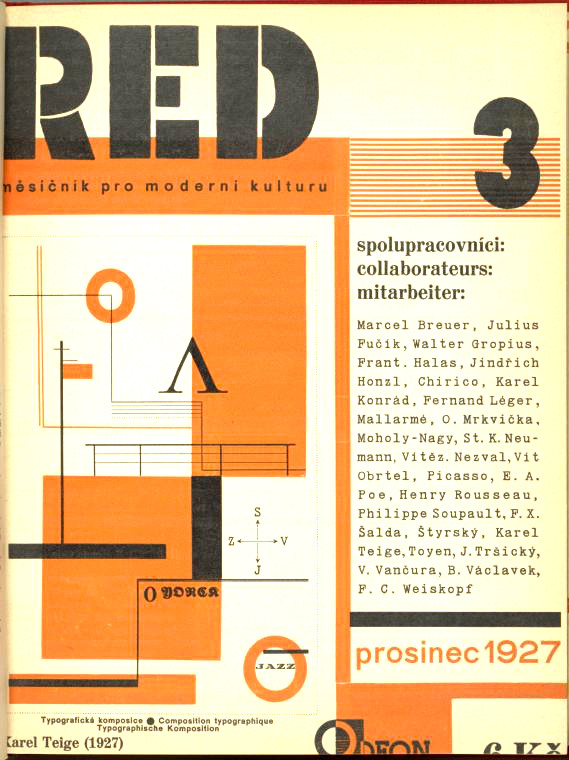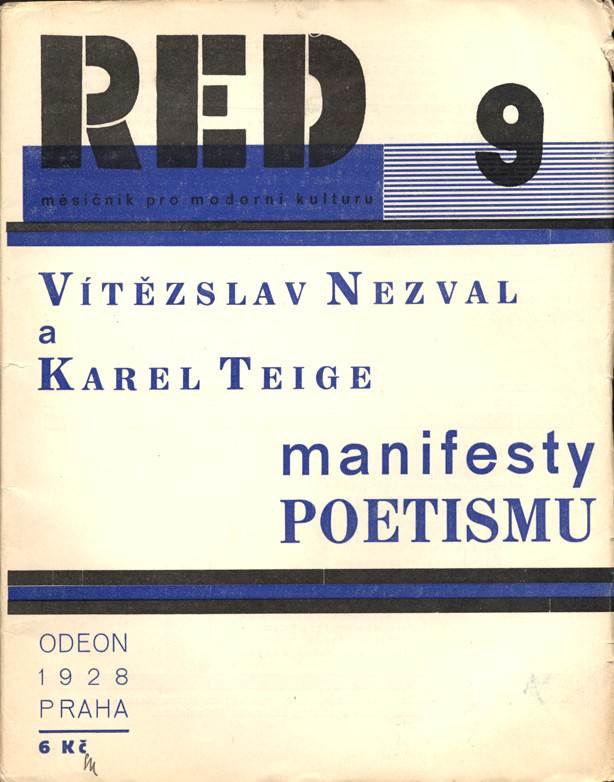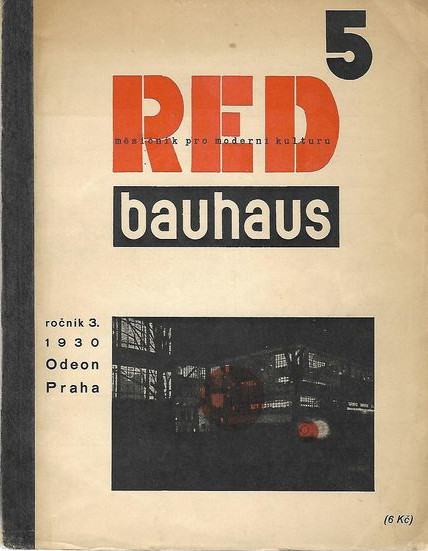Kyōjirō Hagiwara: Death Sentence (1925) [Japanese]
Filed under poetry | Tags: · avant-garde, dada, graphic design, japan, poetry, typography, visual poetry

The poetry anthology Shikei senkoku “is one of Mavo’s best-known projects and the group’s only collaborative book design. Mavo executed the entire layout of Hagiwara’s anthology, deciding everything down to the pitch of the text. It is one of the finest examples of a successful integration of text, design, typography, and illustration.
At the time, Shikei senkoku was considered extremely experimental graphically. As Takahashi Shūichirō has noted, it was designed to fit Hagiwara’s persona as a kuroki hannin (black criminal, that is, an anarchist). Without the artistic constraints placed on many commercial publications, Mavo artists were free to produce a strong visual response to the tumultuous poems. Okada did most of the illustrations for the volume, as well as designing the cover. It consists of two bold black lattices on both the left and right borders, a yellow band at the top with the author’s name, a thicker red band with the book title below this, a bluish circle in the center, and a black-and-white grid pattern at the bottom with boxes filled in to create an abstract pattern. The tide consists of irregularly rendered, blocky characters, playfully tilted against one another, creating a horizontal rhythm across the top of the book.
Several of the illustrations inside Shikei senkoku are photographic reproductions of Mavo work already published in the group’s magazine. The rest are abstract linocuts. Line, dot, and arrow border patterns dynamically frame the texts, which are interspersed with full-page illustrations, some featuring bold, black-and-white abstract patterns.
In one example, illustrations by Okada Tatsuo and Yabashi Kimimaro face each other (pp 34-35). Okada’s untitled print, on the right-hand page, is largely rectilinear, with a few crisscrossing diagonals. The Still Life Yawns, Yabashi’s work on the left-hand page, consists of a black rectangular form with white areas cut away inside, producing free-form shapes. In another of Okada’s many untitled designs in Shikei senkoku, an anthropomorphic head springs into the composition from the left, its segmented neck pierced by a long protruding cone; black-and-white abstract shapes and line patterns animate the background (p 155). The typography used for the poems is also experimental, often incorporating symbols and shapes to substitute for characters and letters (pp 130-131).” (from Gennifer Weisenfeld, Mavo, 2002, pp 197-200)
With illustrations by Mavo (Tatsuo Okada, Kimimaro Yabashi, Tomoyoshi Murayama, Masamu Yanase, Hisao Maki, Shuzo Oura, Seiho Sawa, Tatsuo Toda, Michinao Takamizawa)
Publisher Chōryūsha, Tokyo, 1925
161+6 pages
via Waseda University Library, (2)
Commentary (John Solt, 1999)
MAVO at Monoskop wiki
PDF, JPGs (First edition, PDF 46 MB)
PDF, JPGs (Second edition, PDF 48 MB)
HTML (added on 2014-10-8)
Josef Hiršal, Bohumila Grögerová (eds.): Slovo, písmo, akce, hlas: K estetice kultury technického věku (1967) [Czech]
Filed under book | Tags: · aesthetics, art, art theory, avant-garde, chance, computer art, concrete poetry, experimental art, fluxus, happening, kinetic art, lettrism, literary theory, manifesto, music theory, poetry, technology, visual poetry

A unique anthology of essays, manifestos and artistic programs from the period 1950-1965 by Jasia Reichardt, George Brecht, George Maciunas, Ben Vautier, Eugen Gomringer, Décio Pignatari, Max Bense, Umberto Eco, and others.
“Tento sborník teoretických studií, esejů, článků a uměleckých manifestů napsaných v prvních patnácti letech druhé poloviny dvacátého století, chce být v prvé řade informací. Informací o estetice toho, co bývá globálně nazýváno experimentálním uměním, vznikajícím v technické civilizaci a realizujícím rozličné tendence a programy v různých částech světa. Chce osvětlit tento pojem a poukázat na rozdílnost jeho aplikací i výkladů. Navíc pak chce poskytnout v českém překladu přímo pramenné materiály o nových druzích poezie (o poezii umělé, konkrétní, auditivní, verbofonické, grafické), o umění lettristickém, permutacionálním, totálním, o splývaní dosud samostatných uměleckých disciplín a žánrů i o krystalizaci a výskytu nových, reprezentovaných především akcemi (happening aj.).
Ve sborníku je zařazeno vedle statí, studií a manifestů uměleckých skupin, teoretiků i samotných umělců i několik přehledů historických a vývojových, ukazujících souvislosti současného umění s etapami předchozími a podávajících další důkazy o jeho univerzalitě i diferenciaci. Materiály sborníku netvoří ani v náznaku kompaktní celek. Jsou spíše jednotlivými, někdy dokonce přímo si odporujícími hlasy vzrušeného rozhovoru, vytvářejí konglomerát různých tendencí, názorů a reakcí na skutečnost a stav civilizace druhé poloviny našeho století v rozdílných společenských podmínkách. Záměřem pořadatelů bylo přiblížit je našim zasvěcenějším i laickým čtenářům a poskytnout tak hlubší předpoklady k vnímání současných uměleckých artefaktů i k pochopení jejich metodologie.
Shrnutím nejvýraznějších, mnohdy však i nejproblematičtějších současných estetických tendencí představuje tento sborník materiál, který — právě snad pro svou názorovou diferenciaci, rozpornost a nesmiřitelnost — nemá dosud ve světě obdoby. Bylo by si proto jen přát, aby se názorům a informacím v něm obsaženým dostalo žádoucího doplnění ve zpřístupnění korespondujících konkrétních uměleckých výtvorů jak světové, tak i naší skromnější provecience, resp. v pokračujícím zpřístupňování, protože mnohé již u nás známe jsou. Padly by tak poslední falešné mýty a představy — a to jak ze strany snobů, tak diletantů — a byla by i v této oblasti dokořán otevřena cesta k přirozenému a nevyhnutelnému vývojovému výběru.” (from the Introduction)
With an Afterword by Jiří Levý
Publisher Československý spisovatel, Prague, 1967
Volume 1 of Monoskop Unlimited Edition series
256 pages
PDF (40 MB, no OCR)
Comment (0)ReD (Revue Devětsilu): modern culture monthly (1927-1931) [Czech]
Filed under magazine | Tags: · architecture, art, art theory, avant-garde, bauhaus, constructivism, czechoslovakia, dada, design, film, graphic design, literature, photography, poetry, psychoanalysis, radio, surrealism, theatre



ReD (měsíčník pro moderní kulturu / Revue internationale illustrée de l’activité contemporaine / Internationale Monatsschrift für moderne Gestaltung) was an art magazine published by members of the Czech avant-garde art collective Devětsil.
Thirty numbers were published, with the special issues on the Russian avant-garde, Bauhaus, and photography/film/typography.
Several manifestos appeared in the journal: Toyen and Jindřich Štyrský’s Artificielisme (1:1, 1927), Karel Teige’s second Poetism manifesto [Manifest Poetismu] (1:9, 1928), and the Left Front [Levá fronta]’s founding manifesto (3:2, 1929).
Edited and designed by Karel Teige
Publisher Odeon – Jan Fromek, Prague
via NYPL Digital Library
Each volume in a single PDF (low resolution):
Volume I, 1927-1928 (10 issues, 360 pages)
Volume II, 1928-1929 (10 issues, 324 pages)
Volume III, 1929-1931 (10 issues, 315 pages)
Selected issues in separate PDFs:
The Russian Issue (1:2, Nov 1927)
Foto Film Typo Issue (2:8, Apr 1929)
The Bauhaus Issue (3:5, Feb 1930, partly in German)
JPG pages (search in page annotations):
View online
See also Devětsil: Revoluční sborník (1922), edited by Jaroslav Seifert and Karel Teige, in Czech.
Comment (1)
